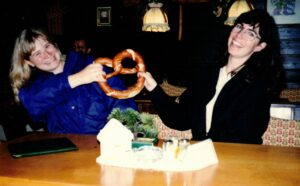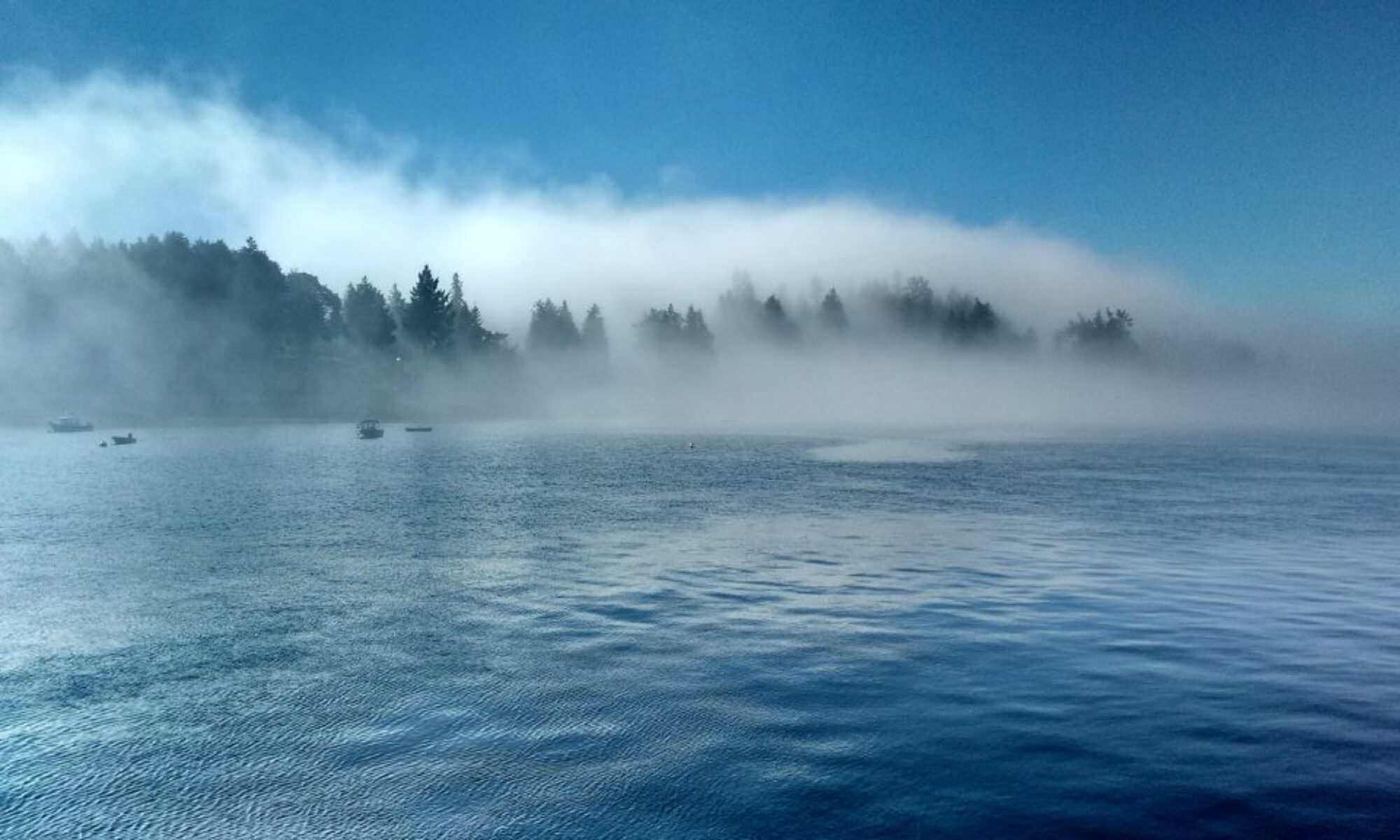
“Oh my gosh, are you okay?!” The first-aid instructor dropped my wrist in surprise after demonstrating to the class how to check a pulse.
It was 1991, just a few days before I’d fly to Europe to work as an assistant tour guide for the first time. I was a young, passionate traveler who’d just landed my dream job at Europe Through the Back Door. And I was so excited that I’d psyched myself into a happy anxiety attack, with a crazy heartbeat as symptom.
If you’ve been a Rick Steves’ Europe tour member in recent years, you might shake your head in wonder at that first tour of mine almost 30 years ago and some of its contrasts with today’s very comfortable, efficient, and systematic operation.
I wasn’t there for Rick’s very earliest tour days. He tells stories of pulling into a European city with a vanful of tour members and instructing them to scatter, find rooms for the group, and then report back(!). By the time I came along, Rick had a staff of five, hotels booked in advance, and a Belgian bus company transporting our groups across the Continent.
But in my early years, Europe Through the Back Door was still very much a small local operation. Before Rick’s PBS series aired, raising his visibility across the country, most of our customers were from the Seattle area. In fact, the office hosted a pre-tour potluck dinner for each group so we could meet before the trip. And most tour members were able to come.
In Rick’s attempt to convince Americans that three weeks of vacation was only decent for a developed nation, all our tours were 21 days long, and we had just two itineraries: the Best of Europe, and the Best of Britain. Every group had both a lead guide and an assistant–who got to know each other very well in the intensity of a three-week, six-country marathon of group togetherness. Airfare wasn’t cheaper—in fact, I remember my flights in the ‘90’s costing about the same as in 2019—but tours were, so I had more penny-pinching 20- and 30-somethings in my groups. Now it seems less common for folks that young to have the time and money.
We still warn our tour members that they need to be physically fit for extensive walking and stair-climbing, but in those days it was even more vital: young or old, we all carried Rick Steves convertible suitcases on our backs, and oh, the sweaty backpack outline that would be revealed when we shucked them off!
And we carried those bags up many flights of stairs. It was a rare luxury to stay in a hotel with an elevator. Air conditioning was unheard of, too. When I returned to guiding in 2011, after a 10-year break to raise my kids, I was astounded when my first hotel room had A/C. I thought the front desk had assigned me the wrong room, since I always ask for the worst one. (Tour members get the nicer ones.) But no! And I thought it was an anomaly—but then we got to the second hotel. And the third. And so on. Still a backpacker and “hostel-er” at heart, I was floored by such luxurious upgrades.

The trepidation of Americans: a shared bathroom. But they weren’t uncommon in our hotels back in 1991. In fact, one of my (and countless tour members’) favorite hotels was the Hotel Mittaghorn in Gimmelwald, in the Swiss Alps. Not only did it have just one shower that most of the rooms shared (I’d post a shower-time sign-up sheet on the door to avoid lineups), but it was coin-operated. The chalet’s big loft would invariably be assigned to the solo women in the group—including me–with beds lined up like the orphans’ in “Madeline.”
Sometimes my groups were split among multiple hotels. The extreme was in Vernazza, the picturesque seaside town in Italy’s Cinque Terre. Before Rick’s TV series supercharged its popularity—and before cruise ships started docking nearby, disgorging daytrippers—it still felt almost undiscovered by Americans.
The unofficial “boss” of the town, who ran one of its restaurants, would arrange rental rooms for us in a hodgepodge of private homes. If you’ve been to Vernazza, you can attest to its maze of steeply staired “streets.” After rooms were assigned and keys handed out, I’d dash, sweaty and panting, up and down those streets checking on my tour members and ensuring they’d all found their tucked-away rooms in half a dozen quirky houses. One time, my own room clearly belonged to the family Grandma or Auntie, who had been kicked out of her own bed moments before I’d checked in. Thirty years later, Vernazza is still gorgeous and worth visiting, but midday, it can be overrun with shoulder-to-shoulder daytrippers, and our tours stay in neighboring towns instead.
In the old days, the lead guide and assistant often shared a room with tour members or with each other. Once in the ‘90’s, I even had to share a room—and its one big bed–with my male colleague. Like an eight-year-old brother and sister in the back seat of Mom’s car, we made a wall of pillows to delineate our territory. These days, we guides always get a private room, so I don’t have to worry about disrupting a roommate’s sleep or monopolizing all the closet space and towels. I invariably keep the lights on late into the night, planning and studying; and I scatter books and receipts, and festoon chairs with my laundry.
That laundry: it was a source of both stress and hilarity for us assistant guides. Believe it or not, it was our duty to wash the tour members’ laundry midway through the tour. Many hours of my first-ever visit to Rome on that 1991 tour were spent dealing with the giant Santa-esque garbage bag full of their dirty clothes. I managed to find a laundromat, and wash and dry it all, but then I spent hours wandering the unfamiliar streets, near tears, in search of my group (this was pre-cell phones, of course). The upside: my every visit to Rome since then has been an improvement. Sorry, tour members now have to wash their own clothes.
Back at the hotel, I’d dump all the clean laundry in a pile on my bed (no, we didn’t go so far as to fold it), and let the tour members paw through it to reclaim their pieces. Our guides’ tradition was to tuck in a racy G-string and, “finding” it among the sensible white crew socks and pleated khakis (remember, this was the ‘90’s), we’d ask innocently, “So, whose is this?!”

In that pre-euro era, I couldn’t arrive in each country and just take my group right out to explore. First I had to read any notes my colleagues on previous tours had left for me at the hotel’s front desk. No internet then, of course—if a guide had news of an impending strike, a change in local museum hours, or a tip about a great new restaurant, we’d just leave a hand-scrawled note at the hotel for the next guide who’d check in. (No cheap, quick way to communicate with home, either. After I married, my husband tried to mail cards to me en route, but they’d invariably arrive too early or late. Eventually he resorted to pre-writing notes for me to take along, labeled with the date I should open each one, and guessing at what he’d be doing and feeling on that day. “Today I went to the Mariners game…unfortunately, they lost again.”)
And then we had to convert our money. Cash was much more widely used, and ATM’s weren’t prevalent. Europe Through the Back Door actually provided tour members with a starter sampler pack of European bills (I remember helping with office assembly lines, stacking up guilders, marks, lire, and Swiss and French francs), but it was necessary to take my groups to an exchange office soon after we arrived. We’d spend precious sightseeing time standing in line at Thomas Cook, waiting to hand over a stack of travelers’ checks in exchange for local currency.
These days I sit in comfort on our tour bus or in my hotel room, using my cell phone and laptop to make reservations and confirm appointments for my tour’s upcoming stops. But that wasn’t possible back then. Instead, I’d buy a prepaid phone card (and each country had its own system), and at our highway rest stops, I’d have to find—and figure out—a pay phone and make a breathless series of calls to my next destination.
Thirty years ago, our tour operation was a little rougher around the edges, a little more seat-of-the-pants, a little less polished. But my tour members’ delight in their discoveries, the friendships and memories created, the lifelong travel dreams come true, were just as precious and meaningful then as now. Hundreds of tour members later, I still get immense joy and satisfaction from each European tour I lead. I just don’t give myself a panic attack beforehand anymore.

Hello! Do you use Twitter? I’d like to follow
you if that would be okay. I’m definitely enjoying your blog and look
forward too nnew articles.
Glad you enjoyed it, Tory! I’m not on Twitter at this point. I’m hoping to add a “subscribe” button to my site really soon so readers can get a notification when I post something new. In the meantime, I post on the “Rick Steves’ Europe Group” Facebook page to alert folks when I post.
Took me time to read all the comments, however I really loved the article. It proved to be very useful to me and Im positive to all of the commenters here! Its all the time good when you cant only learn, but in addition engaged! I am certain you had joy penning this article. Anyway, in my language, there arent much good source like this.
I’m glad that you liked it! I’m interested to know what your first language is.
What a fantastic post, Margaret! Even though I started in 2000, I can still relate to so much of this. Back then Europe was discovering email, & tour members wanted to know where the internet café was in every place we visited! Great memories. Hope you & your family have a wonderful new year!!! Un abrazo fuerte!
Thank you, Robert–that means a lot to me! Yes, remember internet cafes?! The good thing was, when we had to make a special trip to one to check our email, and then we were paying by the minute, we didn’t *linger* online, and then we were more “present” in the rest of our day. These days when we even have wifi on some of the tour buses, I strongly recommend to our tour members *not* to take advantage of it…be in the moment, enjoying your trip! I hope you are well. So sorry not to be able to see you this month.